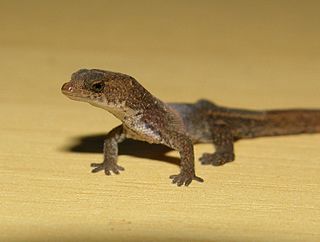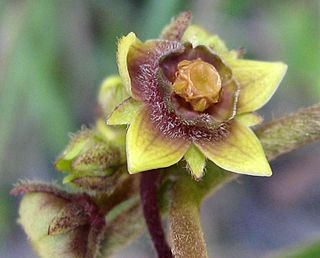
Crocodilurus is a monotypic lizard genus consisting of one species, the crocodile tegu, belonging to the family Teiidae. Its common name is the 'crocodile' tegu, due to its appearance and fondness for water, and is locally known as the jacarerana. This semi-aquatic, predatory lizard has a flattened, paddle-like tail, enabling it to swim with ease.

Cynanchum is a genus of about 300 species including some swallowworts, belonging to the family Apocynaceae. The taxon name comes from Greek kynos and anchein, hence the common name for several species is dog-strangling vine. Most species are non-succulent climbers or twiners. There is some evidence of toxicity.

Pseudophoenix is a genus of palms which is native to the wider Caribbean. Three species of the four species are endemic to Hispaniola, while the fourth, P. sargentii, is widely distributed in the northern Caribbean, Florida, and the Yucatán Peninsula.

Bromelioideae is a subfamily of the bromeliads (Bromeliaceae). This subfamily is the most diverse in the family, represented by the greatest number of genera with about 40. Most of the plants in this group are epiphytes, though some have evolved in, or will adapt to, terrestrial conditions. This subfamily features the most plant types which are commonly cultivated by people, including the pineapple.

Matelea is a genus of flowering plants in the family Apocynaceae. It contains about 200 species, which are commonly known as milkvines. Some people consider Chthamalia to be a synonym to or a subgenus of Matelea.
Ampelozizyphus is a genus of plants in the family Rhamnaceae. It includes two species Ampelozizyphus amazonicus, which is known from Amazonian Peru, Colombia, Venezuela, Guyana, Suriname, French Guiana, and Brazil, and Ampelozizyphus guaquirensis, native to the central portion of the Coastal Cordillera of Venezuela.

Tillandsia matudae is a species of flowering plant in the genus Tillandsia. This species is native to Oaxaca, Chiapas and Guatemala.

The Brazilian pygmy gecko is a species of South American lizard in the family Sphaerodactylidae. The species is monotypic in the genus Chatogekko. It grows to a maximum total length of only 24 millimetres (0.94 in). It is found in leaf litter on the forest floor, and preys on springtails and mites. The species is oviparous.
Copelatus amazonicus is a species of diving beetle. It is part of the genus Copelatus in the subfamily Copelatinae of the family Dytiscidae. It was described by Régimbart in 1889.
Tassadia is a genus of plants in the family Apocynaceae, first described as a genus in 1844. It is native primarily to South America, with one species extending north into Central America, S Mexico, and Trinidad.
Pentacyphus is a genus of plants in the family Apocynaceae, first described as a genus in 1906. It is native to South America.
Batocarpus is a genus of trees in the family Moraceae, native to North and South America.

Ibatia is a genus of flowering plants belonging to the family Apocynaceae.
Ephedranthus is a genus of flowering plants belonging to the family Annonaceae.
Rhytidostemma is a genus of flowering plants belonging to the family Apocynaceae.
Pseudolachnostoma is a genus of flowering plants belonging to the family Apocynaceae.
Phaeostemma is a genus of flowering plants belonging to the family Apocynaceae.
Orinoquia yanomamica is a species of flowering plant in the dogbane family, Apocynaceae. It is a climber endemic to Amazonas state of southern Venezuela. It is the sole species in genus Orinoquia. The species was first named Matelea yanomamica by Gilberto Morillo in 1981. In 2015 Morillo moved the species to its own genus.
Graciemoriana gracieae is a species of flowering plant in the dogbane family, Apocynaceae. It is the sole species in genus Graciemoriana. It is endemic to French Guiana.
Peruviasclepias aliciae is a species of flowering plant in the dogbane family, Apocynaceae. It is the sole species in genus Peruviasclepias. It is a climber endemic to Peru.







